Abstract
During a recent survey of retail fresh foods of animal origin (fish and seafood, raw milk, poultry, and red meats) for organisms of the Aeromonas hydrophila group, we isolated representative strains from the various foods. In this study, we sought to characterize these isolates for biochemical properties and virulence-associated factors and to compare the food isolates with clinical isolates. We identified all food and clinical isolates as A. hydrophila and found that all isolates were typical in their biochemical reactions. Examination of the isolates for various virulence-associated factors indicated that most food and clinical isolates were serum resistant, beta-hemolytic, cytotoxin positive (against Y1 adrenal cells), hemagglutinin positive, Congo red positive, elastase positive, and staphylolysin positive. Mouse 50% lethal doses were log10 8 to 9 CFU for most isolates. All isolates had biotypes identical to those of enterotoxin-positive strains. The public health significance of these organisms in foods is not known at present, although their widespread occurrence and ability to grow competitively in foods kept at 5 degrees C represents a potential hazard.
Full text
PDF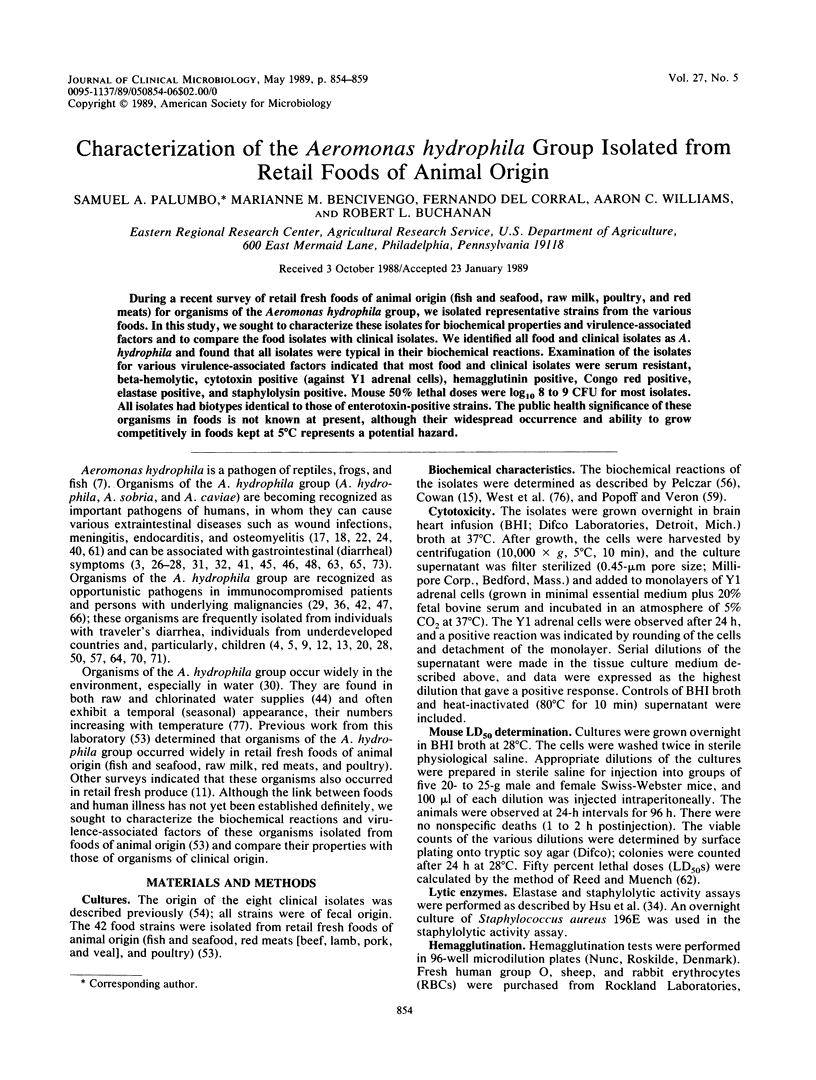
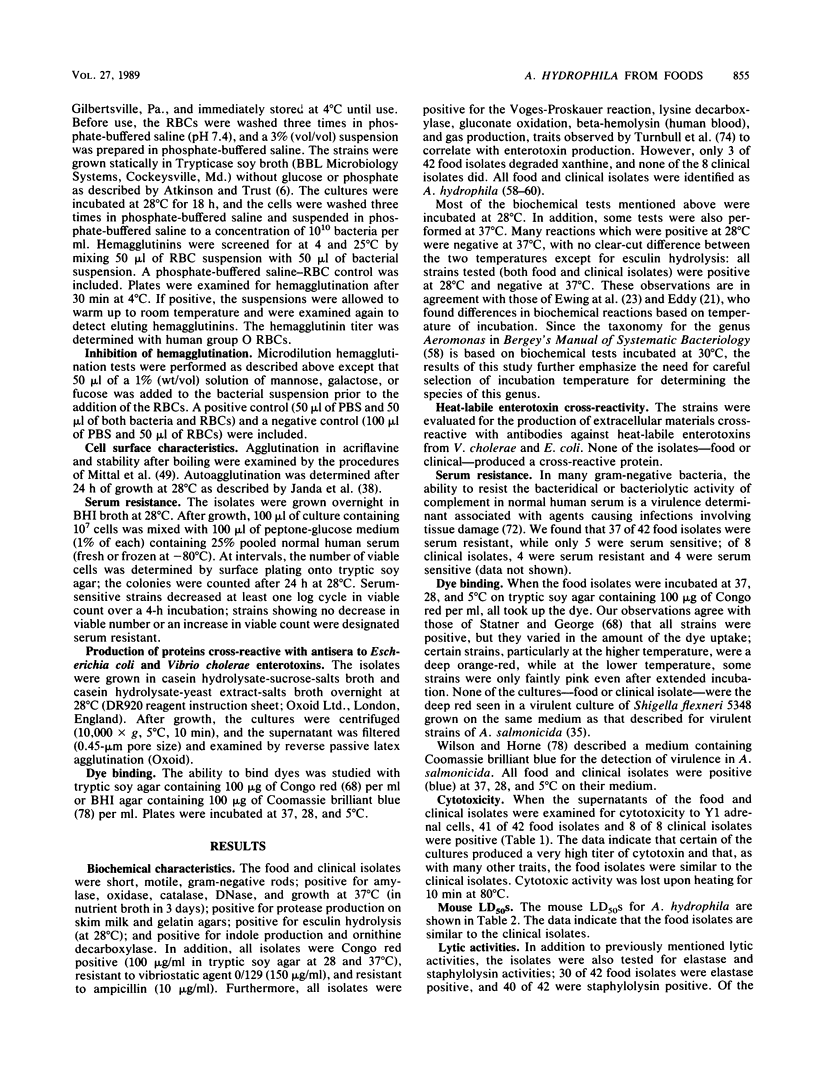
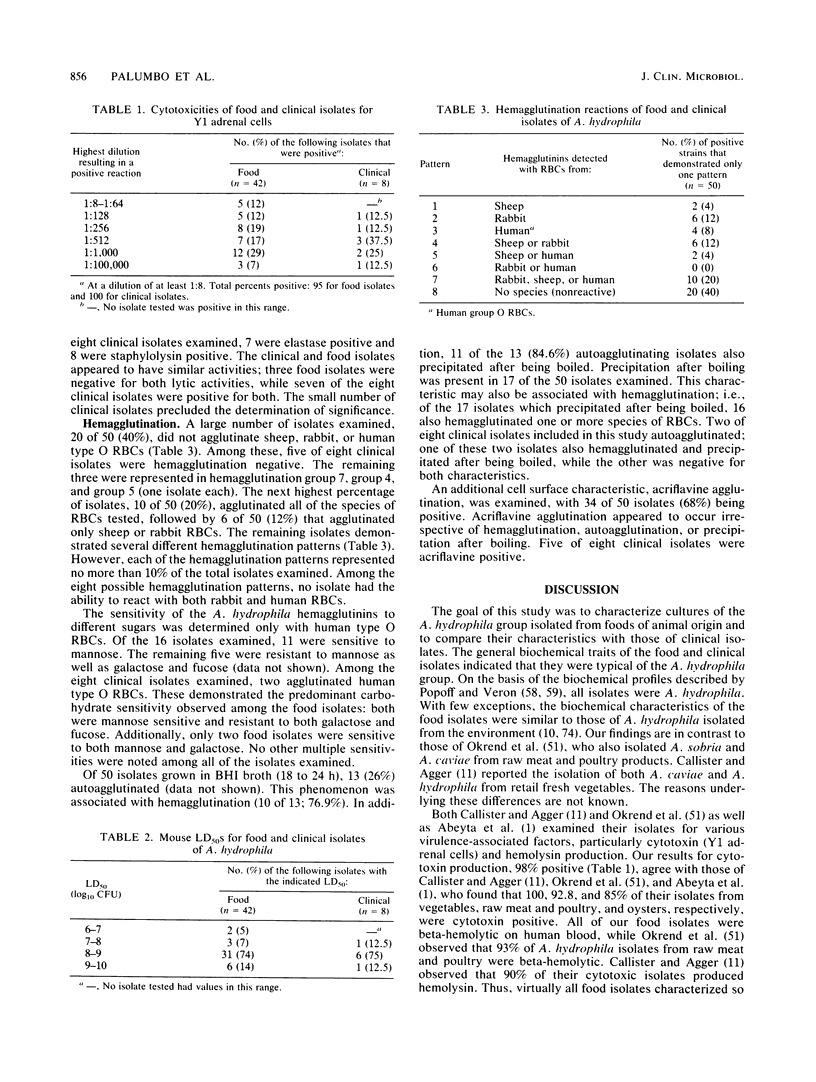
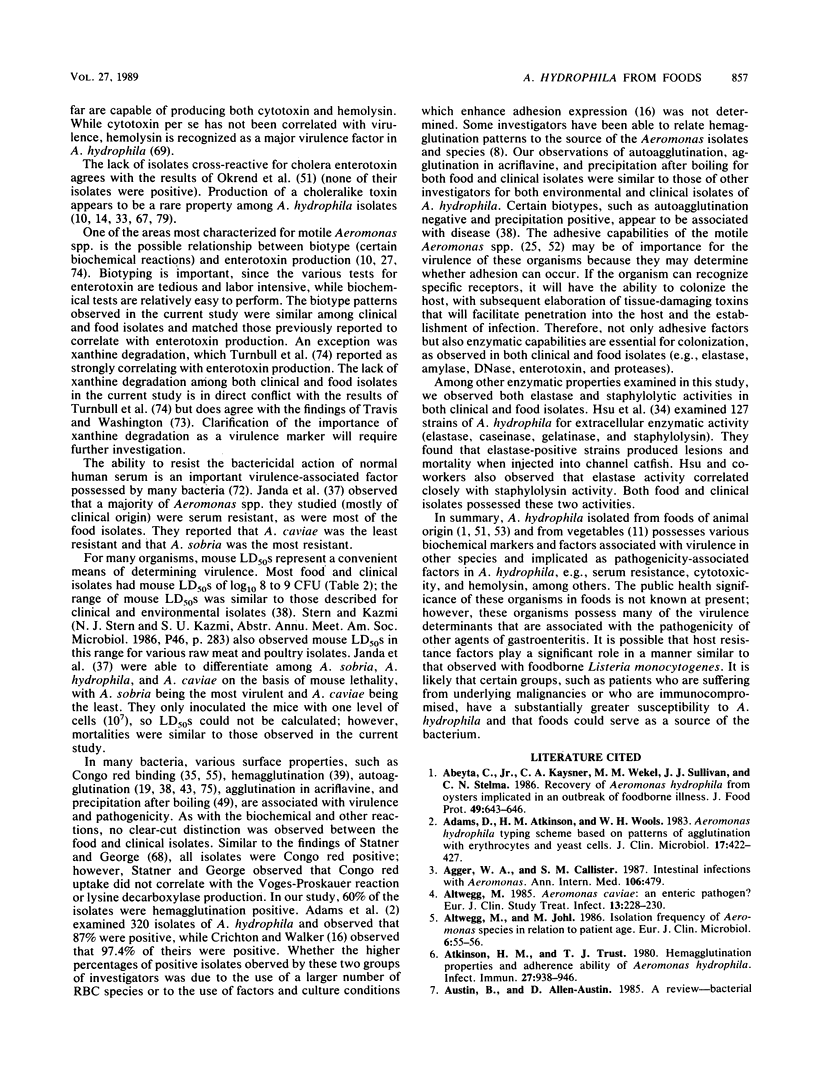
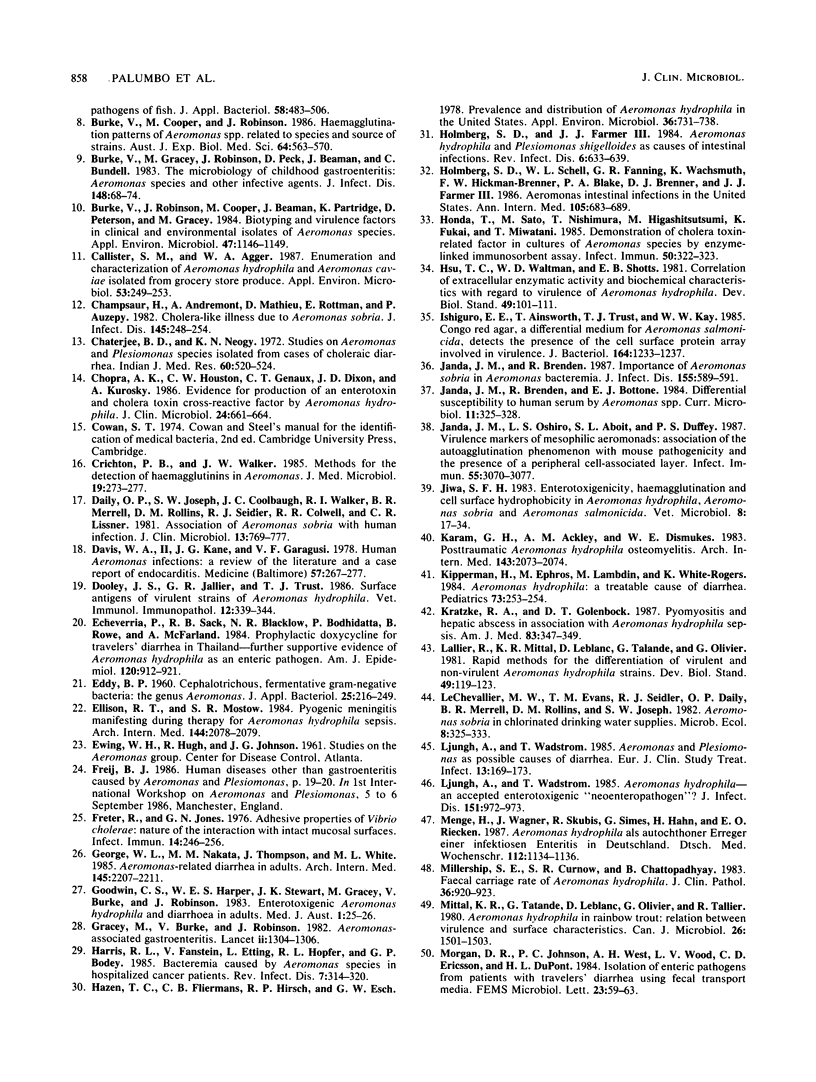
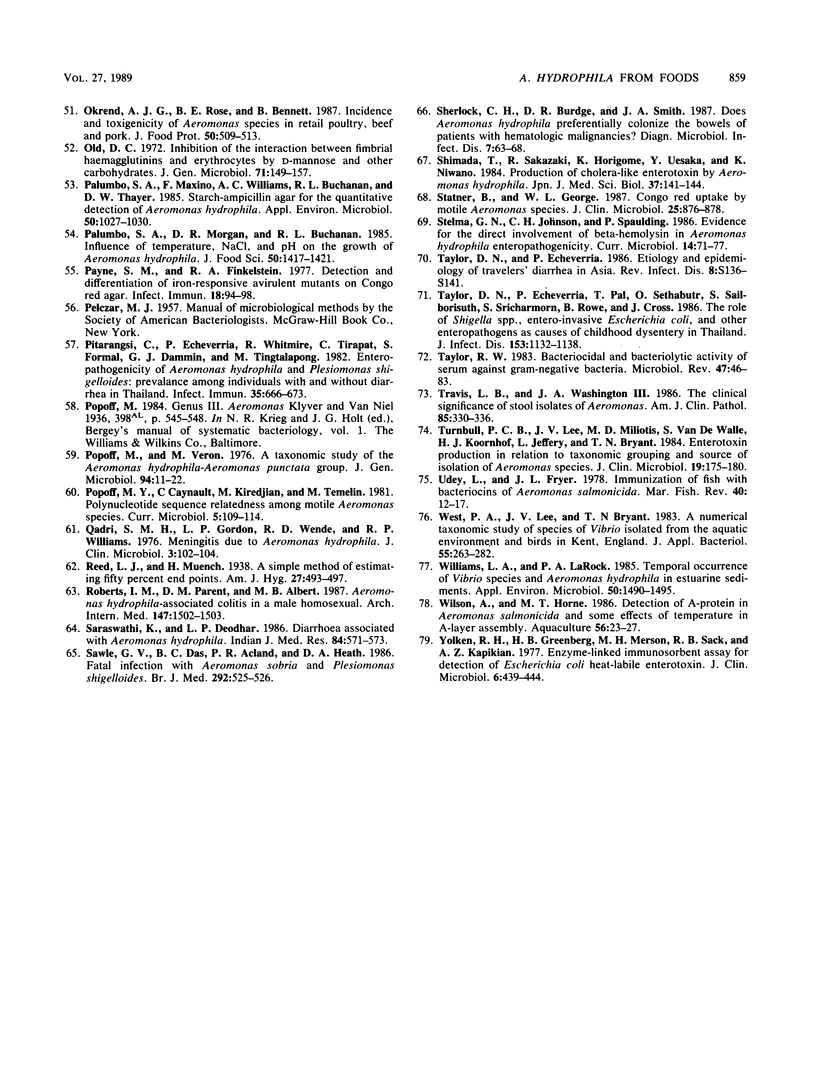
Selected References
These references are in PubMed. This may not be the complete list of references from this article.
- Adams D., Atkinson H. M., Woods W. H. Aeromonas hydrophila typing scheme based on patterns of agglutination with erythrocytes and yeast cells. J Clin Microbiol. 1983 Mar;17(3):422–427. doi: 10.1128/jcm.17.3.422-427.1983. [DOI] [PMC free article] [PubMed] [Google Scholar]
- Agger W. A., Callister S. M. Intestinal infections with Aeromonas. Ann Intern Med. 1987 Mar;106(3):479–479. doi: 10.7326/0003-4819-106-3-479_1. [DOI] [PubMed] [Google Scholar]
- Altwegg M. Aeromonas caviae: an enteric pathogen? Infection. 1985 Sep-Oct;13(5):228–230. doi: 10.1007/BF01667217. [DOI] [PubMed] [Google Scholar]
- Altwegg M., Jöhl M. Isolation frequency of Aeromonas species in relation to patient age. Eur J Clin Microbiol. 1987 Feb;6(1):55–56. doi: 10.1007/BF02097193. [DOI] [PubMed] [Google Scholar]
- Atkinson H. M., Trust T. J. Hemagglutination properties and adherence ability of Aeromonas hydrophila. Infect Immun. 1980 Mar;27(3):938–946. doi: 10.1128/iai.27.3.938-946.1980. [DOI] [PMC free article] [PubMed] [Google Scholar]
- Burke V., Cooper M., Robinson J. Haemagglutination patterns of Aeromonas spp. related to species and source of strains. Aust J Exp Biol Med Sci. 1986 Dec;64(Pt 6):563–570. doi: 10.1038/icb.1986.60. [DOI] [PubMed] [Google Scholar]
- Burke V., Gracey M., Robinson J., Peck D., Beaman J., Bundell C. The microbiology of childhood gastroenteritis: Aeromonas species and other infective agents. J Infect Dis. 1983 Jul;148(1):68–74. doi: 10.1093/infdis/148.1.68. [DOI] [PubMed] [Google Scholar]
- Burke V., Robinson J., Cooper M., Beaman J., Partridge K., Peterson D., Gracey M. Biotyping and virulence factors in clinical and environmental isolates of Aeromonas species. Appl Environ Microbiol. 1984 May;47(5):1146–1149. doi: 10.1128/aem.47.5.1146-1149.1984. [DOI] [PMC free article] [PubMed] [Google Scholar]
- Callister S. M., Agger W. A. Enumeration and characterization of Aeromonas hydrophila and Aeromonas caviae isolated from grocery store produce. Appl Environ Microbiol. 1987 Feb;53(2):249–253. doi: 10.1128/aem.53.2.249-253.1987. [DOI] [PMC free article] [PubMed] [Google Scholar]
- Champsaur H., Adremont A., Mathieu D., Rottman E., Auzepy P. Cholera-like illness due to Aeromonas sobria. J Infect Dis. 1982 Feb;145(2):248–254. doi: 10.1093/infdis/145.2.248. [DOI] [PubMed] [Google Scholar]
- Chatterjee B. D., Neogy K. N. Studies on Aeromonas and Plesiomonas species isolated from cases of choleraic diarrhoea. Indian J Med Res. 1972 Apr;60(4):520–524. [PubMed] [Google Scholar]
- Chopra A. K., Houston C. W., Genaux C. T., Dixon J. D., Kurosky A. Evidence for production of an enterotoxin and cholera toxin cross-reactive factor by Aeromonas hydrophila. J Clin Microbiol. 1986 Oct;24(4):661–664. doi: 10.1128/jcm.24.4.661-664.1986. [DOI] [PMC free article] [PubMed] [Google Scholar]
- Crichton P. B., Walker J. W. Methods for the detection of haemagglutinins in Aeromonas. J Med Microbiol. 1985 Apr;19(2):273–277. doi: 10.1099/00222615-19-2-273. [DOI] [PubMed] [Google Scholar]
- Daily O. P., Joseph S. W., Coolbaugh J. C., Walker R. I., Merrell B. R., Rollins D. M., Seidler R. J., Colwell R. R., Lissner C. R. Association of Aeromonas sobria with human infection. J Clin Microbiol. 1981 Apr;13(4):769–777. doi: 10.1128/jcm.13.4.769-777.1981. [DOI] [PMC free article] [PubMed] [Google Scholar]
- Davis W. A., 2nd, Kane J. G., Garagusi V. F. Human aeromonas infections: a review of the literature and a case report of endocarditis. Medicine (Baltimore) 1978 May;57(3):267–277. [PubMed] [Google Scholar]
- Dooley J. S., Lallier R., Trust T. J. Surface antigens of virulent strains of Aeromonas hydrophila. Vet Immunol Immunopathol. 1986 Jun;12(1-4):339–344. doi: 10.1016/0165-2427(86)90138-8. [DOI] [PubMed] [Google Scholar]
- Echeverria P., Sack R. B., Blacklow N. R., Bodhidatta P., Rowe B., McFarland A. Prophylactic doxycycline for travelers' diarrhea in Thailand. Further supportive evidence of Aeromonas hydrophila as an enteric pathogen. Am J Epidemiol. 1984 Dec;120(6):912–921. doi: 10.1093/oxfordjournals.aje.a113962. [DOI] [PubMed] [Google Scholar]
- Ellison R. T., 3rd, Mostow S. R. Pyogenic meningitis manifesting during therapy for Aeromonas hydrophila sepsis. Arch Intern Med. 1984 Oct;144(10):2078–2079. [PubMed] [Google Scholar]
- Freter R., Jones G. W. Adhesive properties of Vibrio cholerae: nature of the interaction with intact mucosal surfaces. Infect Immun. 1976 Jul;14(1):246–256. doi: 10.1128/iai.14.1.246-256.1976. [DOI] [PMC free article] [PubMed] [Google Scholar]
- George W. L., Nakata M. M., Thompson J., White M. L. Aeromonas-related diarrhea in adults. Arch Intern Med. 1985 Dec;145(12):2207–2211. [PubMed] [Google Scholar]
- Goodwin C. S., Harper W. E., Stewart J. K., Gracey M., Burke V., Robinson J. Enterotoxigenic Aeromonas hydrophila and diarrhoea in adults. Med J Aust. 1983 Jan 8;1(1):25–26. doi: 10.5694/j.1326-5377.1983.tb136018.x. [DOI] [PubMed] [Google Scholar]
- Gracey M., Burke V., Robinson J. Aeromonas-associated gastroenteritis. Lancet. 1982 Dec 11;2(8311):1304–1306. doi: 10.1016/s0140-6736(82)91510-0. [DOI] [PubMed] [Google Scholar]
- Harris R. L., Fainstein V., Elting L., Hopfer R. L., Bodey G. P. Bacteremia caused by Aeromonas species in hospitalized cancer patients. Rev Infect Dis. 1985 May-Jun;7(3):314–320. doi: 10.1093/clinids/7.3.314. [DOI] [PubMed] [Google Scholar]
- Hazen T. C., Fliermans C. B., Hirsch R. P., Esch G. W. Prevalence and distribution of Aeromonas hydrophila in the United States. Appl Environ Microbiol. 1978 Nov;36(5):731–738. doi: 10.1128/aem.36.5.731-738.1978. [DOI] [PMC free article] [PubMed] [Google Scholar]
- Holmberg S. D., Farmer J. J., 3rd Aeromonas hydrophila and Plesiomonas shigelloides as causes of intestinal infections. Rev Infect Dis. 1984 Sep-Oct;6(5):633–639. doi: 10.1093/clinids/6.5.633. [DOI] [PubMed] [Google Scholar]
- Holmberg S. D., Schell W. L., Fanning G. R., Wachsmuth I. K., Hickman-Brenner F. W., Blake P. A., Brenner D. J., Farmer J. J., 3rd Aeromonas intestinal infections in the United States. Ann Intern Med. 1986 Nov;105(5):683–689. doi: 10.7326/0003-4819-105-5-683. [DOI] [PubMed] [Google Scholar]
- Honda T., Sato M., Nishimura T., Higashitsutsumi M., Fukai K., Miwatani T. Demonstration of cholera toxin-related factor in cultures of Aeromonas species by enzyme-linked immunosorbent assay. Infect Immun. 1985 Oct;50(1):322–323. doi: 10.1128/iai.50.1.322-323.1985. [DOI] [PMC free article] [PubMed] [Google Scholar]
- Ishiguro E. E., Ainsworth T., Trust T. J., Kay W. W. Congo red agar, a differential medium for Aeromonas salmonicida, detects the presence of the cell surface protein array involved in virulence. J Bacteriol. 1985 Dec;164(3):1233–1237. doi: 10.1128/jb.164.3.1233-1237.1985. [DOI] [PMC free article] [PubMed] [Google Scholar]
- Janda J. M., Brenden R. Importance of Aeromonas sobria in Aeromonas bacteremia. J Infect Dis. 1987 Mar;155(3):589–591. doi: 10.1093/infdis/155.3.589. [DOI] [PubMed] [Google Scholar]
- Janda J. M., Oshiro L. S., Abbott S. L., Duffey P. S. Virulence markers of mesophilic aeromonads: association of the autoagglutination phenomenon with mouse pathogenicity and the presence of a peripheral cell-associated layer. Infect Immun. 1987 Dec;55(12):3070–3077. doi: 10.1128/iai.55.12.3070-3077.1987. [DOI] [PMC free article] [PubMed] [Google Scholar]
- Jiwa S. F. Enterotoxigenicity, hemagglutination and cell-surface hydrophobicity in Aeromonas hydrophila, A. sobria and A. salmonicida. Vet Microbiol. 1983 Feb;8(1):17–34. doi: 10.1016/0378-1135(83)90016-0. [DOI] [PubMed] [Google Scholar]
- Karam G. H., Ackley A. M., Dismukes W. E. Posttraumatic Aeromonas hydrophila osteomyelitis. Arch Intern Med. 1983 Nov;143(11):2073–2074. [PubMed] [Google Scholar]
- Kipperman H., Ephrds M., Lambdin M., White-Rogers K. Aeromonas hydrophila: a treatable cause of diarrhea. Pediatrics. 1984 Feb;73(2):253–254. [PubMed] [Google Scholar]
- Kratzke R. A., Golenbock D. T. Pyomyositis and hepatic abscess in association with Aeromonas hydrophila sepsis. Am J Med. 1987 Aug;83(2):347–349. doi: 10.1016/0002-9343(87)90710-8. [DOI] [PubMed] [Google Scholar]
- Ljungh A., Wadström T. Aeromonas and plesiomonas as possible causes of diarrhoea. Infection. 1985 Jul-Aug;13(4):169–173. doi: 10.1007/BF01642805. [DOI] [PubMed] [Google Scholar]
- Ljungh A., Wadström T. Aeromonas hydrophila--an accepted enterotoxigenic "neoenteropathogen"? J Infect Dis. 1985 May;151(5):972–973. doi: 10.1093/infdis/151.5.972. [DOI] [PubMed] [Google Scholar]
- Menge H., Wagner J., Skubis R., Simes G., Hahn H., Riecken E. O. Aeromonas hydrophila als autochthoner Erreger einer infektiösen Enteritis in Deutschland. Dtsch Med Wochenschr. 1987 Jul 10;112(28-29):1134–1136. doi: 10.1055/s-2008-1068208. [DOI] [PubMed] [Google Scholar]
- Millership S. E., Curnow S. R., Chattopadhyay B. Faecal carriage rate of Aeromonas hydrophila. J Clin Pathol. 1983 Aug;36(8):920–923. doi: 10.1136/jcp.36.8.920. [DOI] [PMC free article] [PubMed] [Google Scholar]
- Mittal K. R., Lalonde G., Leblanc D., Olivier G., Lallier R. Aeromonas hydrophila in rainbow trout: relation between virulence and surface characteristics. Can J Microbiol. 1980 Dec;26(12):1501–1503. doi: 10.1139/m80-248. [DOI] [PubMed] [Google Scholar]
- Old D. C. Inhibition of the interaction between fimbrial haemagglutinins and erythrocytes by D-mannose and other carbohydrates. J Gen Microbiol. 1972 Jun;71(1):149–157. doi: 10.1099/00221287-71-1-149. [DOI] [PubMed] [Google Scholar]
- Palumbo S. A., Maxino F., Williams A. C., Buchanan R. L., Thayer D. W. Starch-Ampicillin Agar for the Quantitative Detection of Aeromonas hydrophila. Appl Environ Microbiol. 1985 Oct;50(4):1027–1030. doi: 10.1128/aem.50.4.1027-1030.1985. [DOI] [PMC free article] [PubMed] [Google Scholar]
- Payne S. M., Finkelstein R. A. Detection and differentiation of iron-responsive avirulent mutants on Congo red agar. Infect Immun. 1977 Oct;18(1):94–98. doi: 10.1128/iai.18.1.94-98.1977. [DOI] [PMC free article] [PubMed] [Google Scholar]
- Pitarangsi C., Echeverria P., Whitmire R., Tirapat C., Formal S., Dammin G. J., Tingtalapong M. Enteropathogenicity of Aeromonas hydrophila and Plesiomonas shigelloides: prevalence among individuals with and without diarrhea in Thailand. Infect Immun. 1982 Feb;35(2):666–673. doi: 10.1128/iai.35.2.666-673.1982. [DOI] [PMC free article] [PubMed] [Google Scholar]
- Popoff M., Véron M. A taxonomic study of the Aeromonas hydrophila-Aeromonas punctata group. J Gen Microbiol. 1976 May;94(1):11–22. doi: 10.1099/00221287-94-1-11. [DOI] [PubMed] [Google Scholar]
- Qadri S. M., Gordon L. P., Wende R. D., Williams R. P. Meningitis due to Aeromonas hydrophila. J Clin Microbiol. 1976 Feb;3(2):102–104. doi: 10.1128/jcm.3.2.102-104.1976. [DOI] [PMC free article] [PubMed] [Google Scholar]
- Roberts I. M., Parenti D. M., Albert M. B. Aeromonas hydrophila-associated colitis in a male homosexual. Arch Intern Med. 1987 Aug;147(8):1502–1503. [PubMed] [Google Scholar]
- Saraswathi K., Deodhar L. P. Diarrhoea associated with Aeromonas hydrophila. Indian J Med Res. 1986 Dec;84:571–573. [PubMed] [Google Scholar]
- Sawle G. V., Das B. C., Acland P. R., Heath D. A. Fatal infection with Aeromonas sobria and Plesiomonas shigelloides. Br Med J (Clin Res Ed) 1986 Feb 22;292(6519):525–526. doi: 10.1136/bmj.292.6519.525. [DOI] [PMC free article] [PubMed] [Google Scholar]
- Sherlock C. H., Burdge D. R., Smith J. A. Does Aeromonas hydrophila preferentially colonize the bowels of patients with hematologic malignancies? Diagn Microbiol Infect Dis. 1987 May;7(1):63–68. doi: 10.1016/0732-8893(87)90072-1. [DOI] [PubMed] [Google Scholar]
- Shimada T., Sakazaki R., Horigome K., Uesaka Y., Niwano K. Production of cholera-like enterotoxin by Aeromonas hydrophila. Jpn J Med Sci Biol. 1984 Jun;37(3):141–144. doi: 10.7883/yoken1952.37.141. [DOI] [PubMed] [Google Scholar]
- Statner B., George W. L. Congo red uptake by motile Aeromonas species. J Clin Microbiol. 1987 May;25(5):876–878. doi: 10.1128/jcm.25.5.876-878.1987. [DOI] [PMC free article] [PubMed] [Google Scholar]
- Taylor D. N., Echeverria P. Etiology and epidemiology of travelers' diarrhea in Asia. Rev Infect Dis. 1986 May-Jun;8 (Suppl 2):S136–S141. doi: 10.1093/clinids/8.supplement_2.s136. [DOI] [PubMed] [Google Scholar]
- Taylor D. N., Echeverria P., Pál T., Sethabutr O., Saiborisuth S., Sricharmorn S., Rowe B., Cross J. The role of Shigella spp., enteroinvasive Escherichia coli, and other enteropathogens as causes of childhood dysentery in Thailand. J Infect Dis. 1986 Jun;153(6):1132–1138. doi: 10.1093/infdis/153.6.1132. [DOI] [PubMed] [Google Scholar]
- Taylor P. W. Bactericidal and bacteriolytic activity of serum against gram-negative bacteria. Microbiol Rev. 1983 Mar;47(1):46–83. doi: 10.1128/mr.47.1.46-83.1983. [DOI] [PMC free article] [PubMed] [Google Scholar]
- Travis L. B., Washington J. A., 2nd The clinical significance of stool isolates of aeromonas. Am J Clin Pathol. 1986 Mar;85(3):330–336. doi: 10.1093/ajcp/85.3.330. [DOI] [PubMed] [Google Scholar]
- Turnbull P. C., Lee J. V., Miliotis M. D., Van de Walle S., Koornhof H. J., Jeffery L., Bryant T. N. Enterotoxin production in relation to taxonomic grouping and source of isolation of Aeromonas species. J Clin Microbiol. 1984 Feb;19(2):175–180. doi: 10.1128/jcm.19.2.175-180.1984. [DOI] [PMC free article] [PubMed] [Google Scholar]
- West P. A., Lee J. V., Bryant T. N. A numerical taxonomic study of species of Vibrio isolated from the aquatic environment and birds in Kent, England. J Appl Bacteriol. 1983 Oct;55(2):263–282. doi: 10.1111/j.1365-2672.1983.tb01324.x. [DOI] [PubMed] [Google Scholar]
- Williams L. A., Larock P. A. Temporal Occurrence of Vibrio Species and Aeromonas hydrophila in Estuarine Sediments. Appl Environ Microbiol. 1985 Dec;50(6):1490–1495. doi: 10.1128/aem.50.6.1490-1495.1985. [DOI] [PMC free article] [PubMed] [Google Scholar]
- Yolken R. H., Greenberg H. B., Merson M. H., Sack R. B., Kapikian A. Z. Enzyme-linked immunosorbent assay for detection of Escherichia coli heat-labile enterotoxin. J Clin Microbiol. 1977 Nov;6(5):439–444. doi: 10.1128/jcm.6.5.439-444.1977. [DOI] [PMC free article] [PubMed] [Google Scholar]


